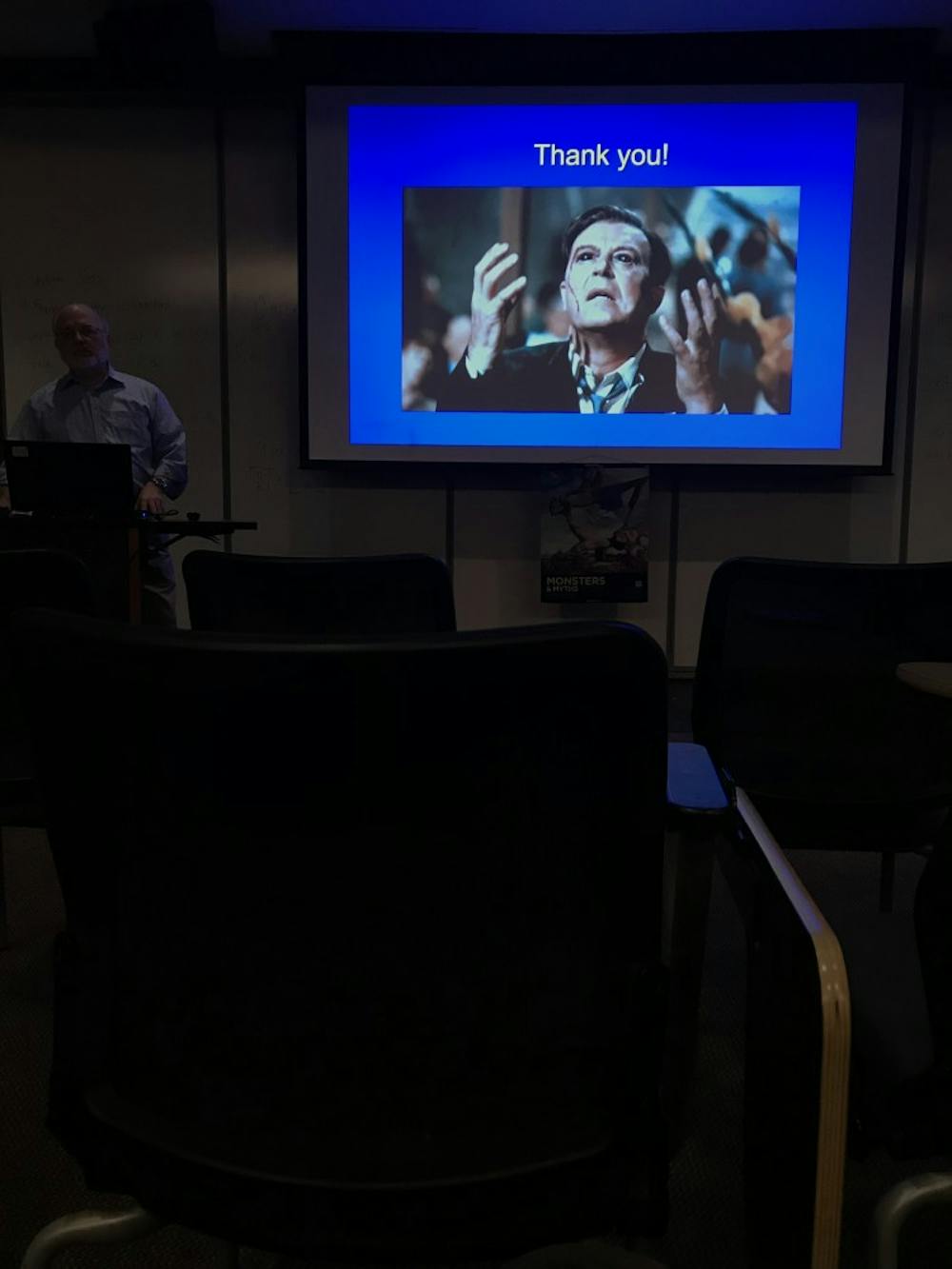When Peter Kaplan sees a movie character, often the monstrous villain in science fiction movies, he finds himself diagnosing them.
When he first saw the disfigured Quasimodo, the titular character of The Hunchback of Notre Dame, he saw neurofibromatosis, which causes tumors to form on elements of the nervous system, possibly as a result of spinal tuberculosis.
To him, director John Carpenter’s The Thing, was a teratoma, a tumor made of tissues like hair, teeth or bone.
For Kaplan, these characters were not simply objects of shock and fear, but aberrations in medicine and science.
So when he opened his talk “From Medicine and Neurophysiology to Myth: Science and Fiction in Hollywood,” he urged the audience to infuse the movie characters with humanity and view them with the compassion that one might have for a patient at a clinic.
“Even though the subjects are characters which are objects of derision or horror, remember that they are largely humans with certain afflictions,” he said.
The talk was a part of the Medicine, Science and Humanities (MSH) Fall 2019 Symposium. Kaplan is a professor of Neurology at the School of Medicine and the director of epilepsy and electroencephalography (EEG) at the Bayview Medical Center.
His expertise is in epilepsy, clinical neurophysiology and convulsive status epilepticus. His current research investigates confusional states and EEG, which is a technique used to record electrical activity in the brain.
In between his research endeavors and clinical appointments, Kaplan devotes time to what he calls his “quirky indulgence” and examines science fiction in film and underpinnings in neurophysiology.
Sophomore Ananda Thomas, who is majoring in MSH, was inspired by Kaplan’s unconventional interest.
“That’s what I envision for myself. I want to go on to medical school but I also want to be passionate about something completely outside the realm of medicine,” she said in an interview with The News-Letter.
Kaplan’s interest in neurology, EEG and epilepsy was piqued by his proximity to a landmark which is closely tied to science fiction. His childhood home was only a short walk from Villa Diodati near Lake Geneva in Switzerland, where Mary Shelley wrote Frankenstein. In fact, Kaplan has seen the lightning storms near Chillon Castle which Shelley describes in her novel.
Kaplan spoke in detail about the scientific origins of Frankenstein.
Electrostatics began with the development of Leyden jars, contraptions which allowed, for the first time, electric charge to be stored and discharged at will. Leyden jars and other electrostatic devices moved out of being parlor tricks and found their way into treatments.
Kaplan described how the manipulation of electricity then became vogue. The idea of manipulating electricity to spark life gained credence when Luigi Galvani stimulated a dead frog’s legs to twitch and contract.
According to Kaplan, Galvani’s experiments were initially viewed with fascination. Images of Galvani dangling frog legs were plastered on chocolate boxes.
But when Galvani’s nephew, Giovanni Aldini, began experimenting with oxen and the decapitated bodies of criminals, the fascination turned largely into fear. Aldini’s experiments suggested that one could produce life by imbuing it with electricity.
Newspapers at the time ran stories about the possibility of a galvanized corpse which stoked fears of the undead roaming the streets.
At around the same time, movies were invented by the Lumière brothers in France. Not long after, Hollywood began experimenting with science fiction and horror films.
Science fiction and horror are not limited to exaggerated uses of techniques and scientific instruments. Kaplan noted that villainous film characters usually have metabolic, genetic, acquired traumatic or degenerative disorders.
“Many villains are distortions of scientific issues which come back to frighten us,” he quipped.
For example, Kaplan described striking similarities between descriptions of vampires in myth and individuals afflicted with porphyrias. The individuals are treated with blood transfusions. They cannot be exposed to sunlight because they will blister. Their fingers are clubbed and they have a small stature. Their teeth and urine fluoresce under ultraviolet light. Vampires suck blood, avoid sunlight, have deformed fingernails and hands and a stooped posture.
Vampires’ sharp, pointed teeth and dark eyes are also characteristics of people with Hidrotic ectodermal dysplasia 2.
Or consider the werewolf. Clinical lycanthropy is a rare psychiatric disorder which places individuals under the illusion that they have metamorphosized into an animal, which can sometimes be a wolf. When patients are placed under brain scans, the parts of their brain which are active suggest that the delusion is real to them and they believe that they have a change in what Kaplan calls their “body habitus.”
A more common parallel exists between werewolves and patients with hirsutism. Hirsutism involves excessive, coarse hair on the face and body. It can be genetically passed down or induced by ingesting toxic chemicals.
Kaplan speculated that perhaps the Invisible Man, who became transparent when his experimentation with light refraction of tissue went awry, has an extreme form of albinism. Albinos lack skin pigmentation which can give them the appearance of being translucent.
In referring to the story of Dr. Jekyll and Mr. Hyde, Kaplan did not draw a comparison to an illness, but instead spoke about how while doctors are highly regarded, they are also viewed with a certain degree of suspicion.
“We respect doctors, but we are also frightened by them,” he noted.
Overall, Kaplan’s lecture was expansive and touched on a variety of topics.
“We covered chemistry, biology, physics, medicine, hematology, genetics, teratology, oncology, gene splicing, hematology, cloning, neurology,” he said. “And we did it all through film.”
The topic wasn’t the only draw for junior Mohammed Mumtaz. He attended the symposium to meet others in the MSH major and engage with MSH outside the classroom.
“Monsters are always interesting,” Mumtaz said in an interview with The News-Letter. “And I also wanted to meet the people in my major and to see how MSH actually manifests as an interdisciplinary subject in the real world.”





